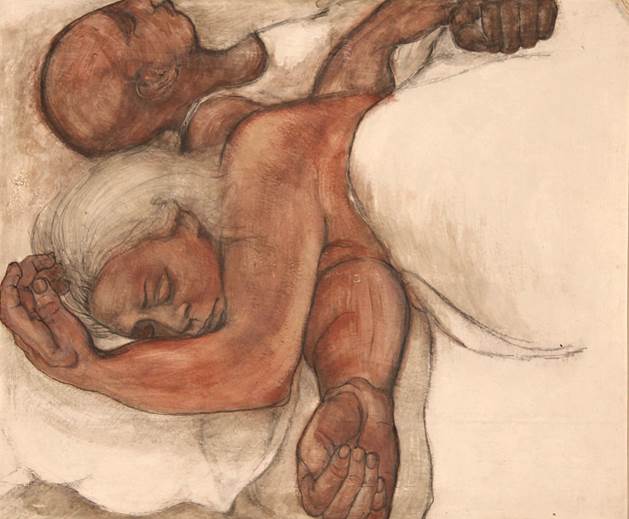Today is the birthday of Andy Warhol, born August 6, 1928. Late in 2013, Crystal Bridges received a remarkable gift from Arkansas donor Martha Sutherland—a painting she purchased from the young Andy Warhol in 1948 while they were both students at Carnegie Technical Institute and the Andy went by his given name, Andrew Warhola. The work showcases the young artist’s formidable draftsmanship abilities—particularly evident in the hands and faces of the figures. But few viewers familiar with Warhol’s most famous works would identify this painting as his. It bears almost none of the stylistic elements characteristic of Warhol’s well-known Pop Art works such as Dolly Parton or Hammer and Sickle, now in Crystal Bridges’ collection. Warhol would not adopt that style until much later in his career. Below, excerpted from an article published in the May, 2014 issue of C magazine, is a brief sketch of Andy in his youth.

Andy Warhol, Untitled, 1949
Tempera, graphite, and ink on board
Gift of Martha Sutherland and Celia Sutherland Wirth
Born Andrew Warhola, Andy was the youngest of three boys. His parents were poor Czechoslovakian immigrants. Andy’s father, Andrei, was a stern man who died of peritonitis when Andy was 13. His mother Julia, however, was made of very different stuff. Though her English was never good, she loved to gossip and tell stories and draw pictures of cats. She doted on Andy, whom she seems to have felt required special care. (Shortly after Andy moved to New York, Julia joined him. She lived with Andy for most of the rest of her life, cooking for him, badgering him to find a good wife, and cleaning up after the 20-odd cats—all named Sam—who inhabited their quarters). Even Andrei, for whom the Warhola boys seemed to feel equal parts terror and awe, saw in the young Andrew something special. Shortly before he died, he told Andy’s brother John: “You’re going to be real proud of Andy….He’s going to be highly educated, he’s going to college.” When Andrei died, Julia hoarded away the little money he had saved up to assure that this would be possible.
As a child, Andy was sensitive and small, and was often picked on as a “crybaby.” (He would later refer to himself as a “sissy” and a “momma’s boy.”) His physical appearance also set him apart. When he was eight years old, Andy contracted rheumatic fever, a disease that was still relatively common in poor neighborhoods. As a subsequent side-effect, he was struck with the tremors known as “St. Vitus’ Dance.” These became progressively worse, and eventually his doctor ordered him to stay at home in bed for four weeks, at the end of which he suffered an immediate relapse and returned to bed for another month. The disease took its toll on Andy’s complexion, leaving him with a notable pallor and piebald patches on his face that would make him feel self-conscious and unattractive for the rest of his life.
In The Philosophy of Andy Warhol, Warhol wrote that in high school: “I wasn’t very close to anyone….I wasn’t the type they wanted to confide in, I guess.” But by the time he went to college, Martha Sutherland remembers him as being surrounded by friends, despite his odd looks. “He was part of a group where the action was. Either he collected people around him or they coalesced around him. He was sort of outrageous in his way. He was different…. He was not very tall and he was very thin and kind of…electric. And good. You know, everybody knew how good he was. His drawing was marvelous.”
Despite Andy’s indisputable abilities, however, Andy failed a class in his first year at Carnegie Tech. The class was “Thought and Expression.” It required regular essay work, at which Andy never excelled. But he had difficulty with most of his classes that first year. He often failed to complete assignments as given—he would throw together slapdash projects, or cut up a single painting and turn it in as four assignments, or in some other way present work that was just different.
Sidney Simon, one of Warhol’s fellow students, said of Andy: “They couldn’t teach him anything and he couldn’t learn anything. He had his own style and direction from the beginning.” Because of this, the faculty, who graded student work through a jury system, couldn’t agree as to whether Andy’s work was any good. His assignments often passed by a single vote. One of his instructors later said: “If anyone would have asked me who was least likely to succeed, I would’ve said Andy Warhola.”




